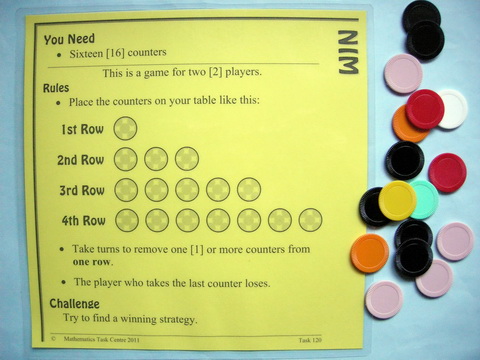
NimTask 120 ... Years 2 - 8SummaryEasy to state and easy to start, this logic game has more to it than appears at first sight. Students might see it as 'just a game', however the game can be analysed and it reveals a connection between winning strategies and odd and even numbers.Counters are arranged in four rows, 1, 3, 5 & 7, and players take turns to remove any number (including the whole row) from one row. The player who has to remove the last counter loses the game. |
Materials
Content
|

IcebergA task is the tip of a learning iceberg. There is always more to a task than is recorded on the card. |
Students are sure to play this game without thinking too deeply when they begin, that is, just for fun. However, the iceberg question we want to encourage them to ask and analyse is: Can we discover a winning strategy?Doing so revolves around realising that it is not the number of counters that are left at any stage, but rather the number of possible moves that are left.
Encourage students to use 'if-then' reasoning to explore and record what could happen from this position.
One way to approach this investigation is to break the problem into parts:
|
Whole Class InvestigationTasks are an invitation for two students to work like a mathematician. Tasks can also be modified to become whole class investigations which model how a mathematician works. |
All you need to turn this task into a whole class investigation is lots of counters. Poly Plug work beautifully. Begin by asking two students to be your demonstration players and work at their table with other students gathered around. This will clarify the rules, which you can also confirm by writing them on the board following the demonstration. Then proceed, guided by the information above, to hunt for all winning positions. For more ideas and discussion about this investigation, open a new browser tab (or page) and visit Maths300 Lesson 79, Nim, which includes an Investigation Guide. Visit Nim in Menu Maths Pack B. |
Is it in Maths With Attitude?Maths With Attitude is a set of hands-on learning kits available from Years 3-10 which structure the use of tasks and whole class investigations into a week by week planner. |
The Nim task is an integral part of:
The Nim lesson is an integral part of:
|